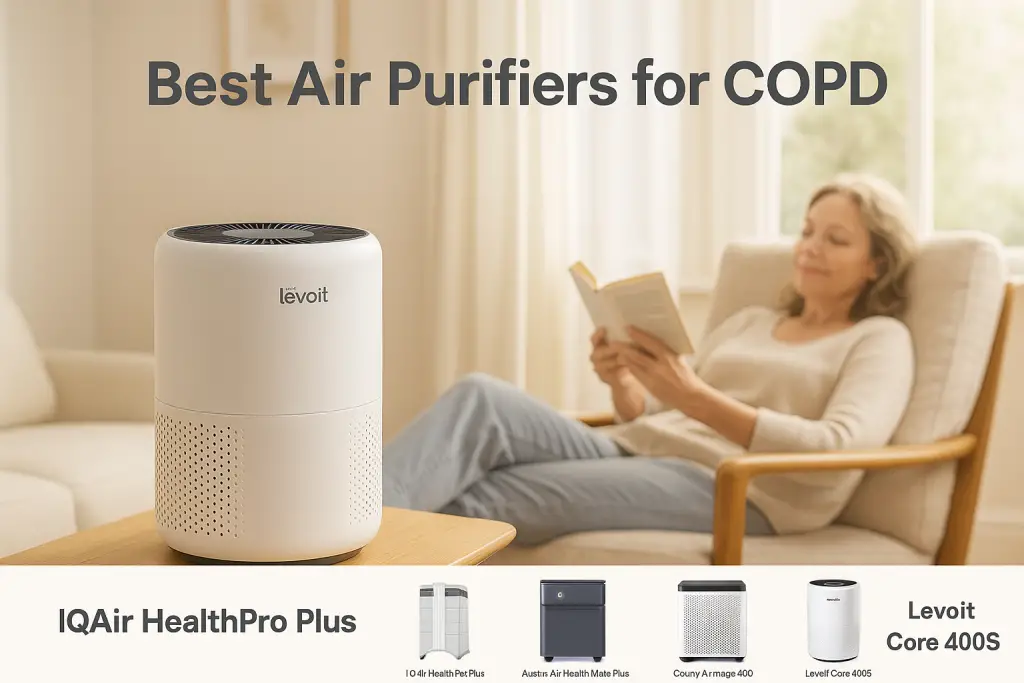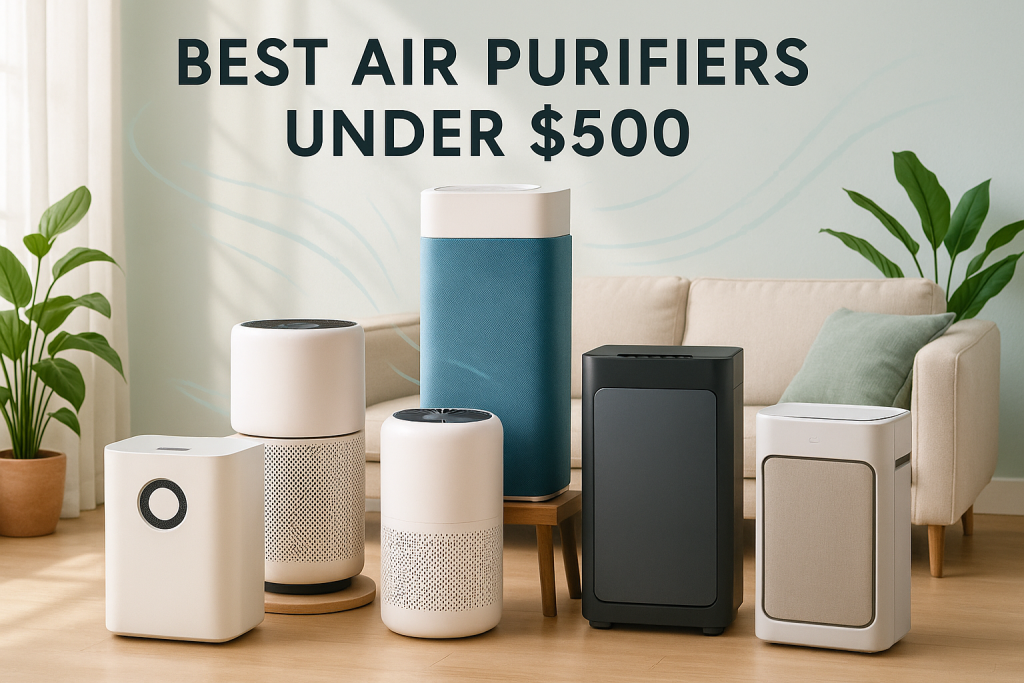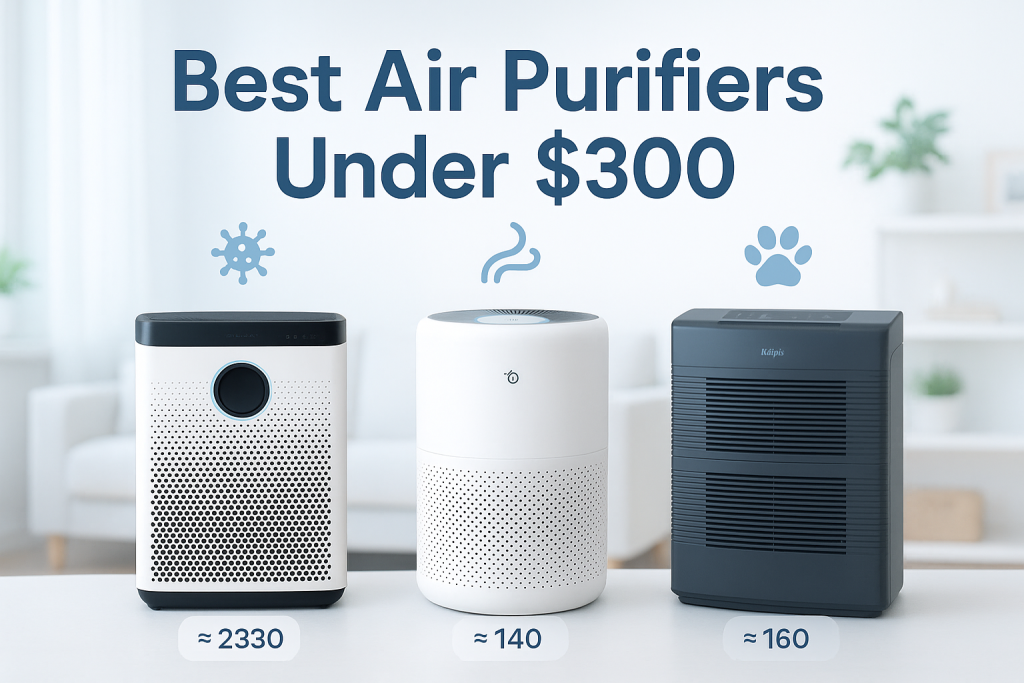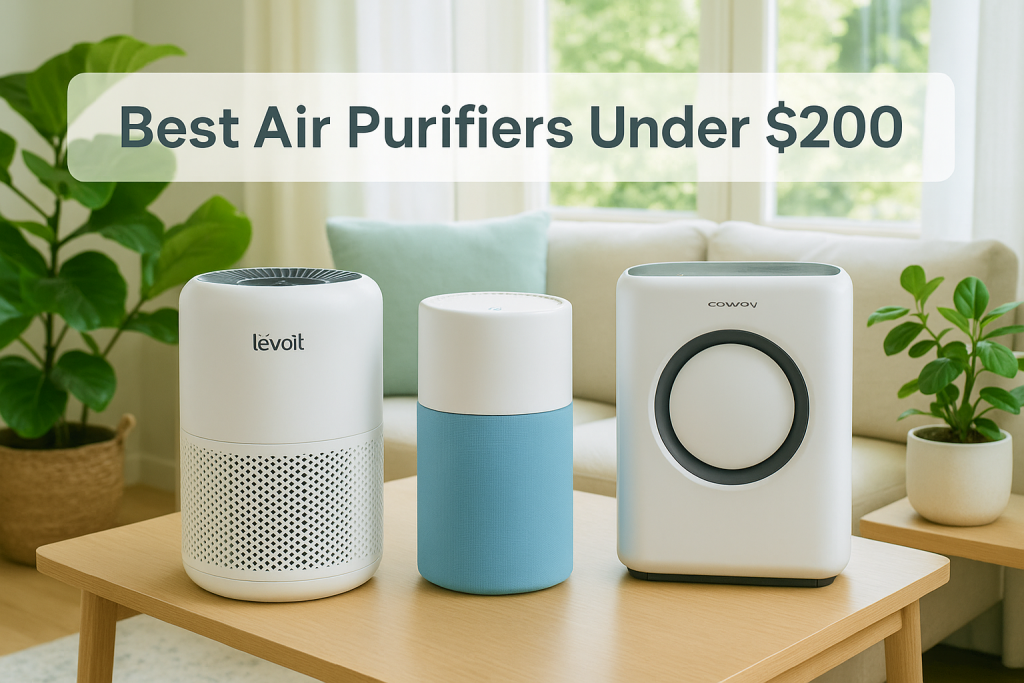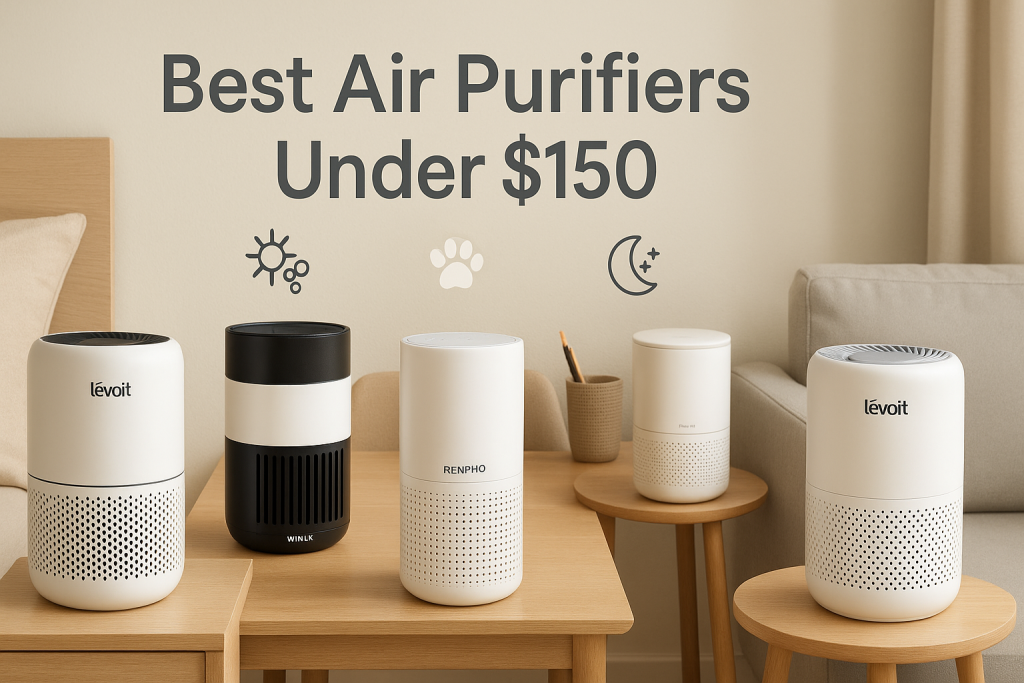Living with Chronic Obstructive Pulmonary Disease (COPD) means paying close attention to air quality. Air purifiers can significantly improve indoor air by removing harmful particles that trigger COPD symptoms. The right air purifier can reduce airborne irritants, helping you breathe easier and potentially reducing flare-ups. This guide examines the most effective air purifiers specifically for COPD management, based on medical evidence and filtration performance.
Understanding How Air Purifiers Can Help Manage COPD Symptoms
Air purifiers can help manage COPD symptoms by removing airborne triggers that worsen breathing difficulties. Here’s what the clinical evidence shows about their effectiveness for respiratory conditions like COPD.
COPD patients experience inflammation and bronchospasm when exposed to particulate matter and irritants. These particles, often smaller than 2.5 microns (PM2.5), can penetrate deep into the lungs, worsening symptoms. High-quality air purifiers targeting PM2.5 particles provide significant benefits by removing these microscopic irritants from your breathing air.
The most problematic indoor air pollutants for COPD patients include:
- Fine dust particles
- Pollen and other allergens
- Mold spores
- Pet dander
- Volatile Organic Compounds (VOCs)
- Smoke particles
Studies published in the European Respiratory Journal show that reducing these airborne triggers can lead to fewer symptom flare-ups. Dr. Michael Wechsler, pulmonologist at National Jewish Health, notes: “Many COPD patients report easier breathing and reduced symptom severity after implementing air purification strategies in their homes.”
While air purifiers can’t cure COPD, they can create a cleaner breathing environment that may reduce the frequency and severity of symptoms. This complementary approach works best alongside proper medical treatment and lifestyle management.
Essential Features to Look for in Air Purifiers for COPD
When selecting an air purifier specifically for COPD management, certain features are non-negotiable while others depend on your specific living situation and symptoms.
Understanding HEPA Filtration for Respiratory Conditions
True HEPA filtration is the gold standard for COPD air purification because it removes 99.97% of particles as small as 0.3 microns—including many respiratory irritants that trigger COPD symptoms.
True HEPA filters capture particles through three mechanisms:
- Interception: Particles stick to filter fibers as they pass through
- Impaction: Larger particles collide with and stick to fibers
- Diffusion: Smallest particles move erratically and eventually contact filter fibers
The American Lung Association recommends HEPA air purifiers for people with respiratory conditions. Be wary of “HEPA-type” or “HEPA-like” filters, which don’t meet the same strict standards as true HEPA filters.
The Importance of Activated Carbon for Chemical Irritant Removal
Many COPD patients are sensitive to chemical irritants like VOCs, odors, and gases that HEPA filters alone cannot capture. This is where activated carbon filtration becomes essential.
Chemical triggers that commonly worsen COPD symptoms include:
- Cleaning product fumes
- Perfumes and air fresheners
- Formaldehyde from furniture and building materials
- Cooking odors
- Paint and solvent vapors
Quality activated carbon filters contain porous carbon that adsorbs these gases and chemicals. The more carbon in the filter, the more effective and longer-lasting it will be. This feature is particularly important for former smokers, whose airways may be more sensitive to chemical irritants.
Other essential features include:
- CADR Rating: Clean Air Delivery Rate measures how quickly an air purifier filters air. Higher numbers mean faster purification.
- Room Coverage: Match the purifier to your room size. For COPD patients, it’s better to choose a unit rated for a slightly larger area than your room.
- Noise Level: Since 24/7 operation is ideal, low noise levels (under 50 dB on medium settings) are important.
- Energy Efficiency: Look for ENERGY STAR certification to ensure reasonable electricity costs.
- Filter Replacement Indicators: These help ensure timely maintenance.
- Easy-to-Use Controls: Accessible buttons or remote operation helps during breathing difficulties.
The 9 Best Air Purifiers for COPD Patients
Based on our analysis of filtration efficiency, COPD-specific features, and medical recommendations, these are the best air purifiers for managing respiratory symptoms associated with COPD.
| Model | Filtration | Room Coverage | CADR | Noise Level | Special Features | Price Range |
|---|---|---|---|---|---|---|
| IQAir HealthPro Plus | HyperHEPA, V5-Cell | 1,125 sq ft | 300+ | 25-59 dB | Medical-grade filtration | $$$ |
| Austin Air HealthMate Plus | True HEPA, 15 lbs Carbon | 1,500 sq ft | 400 | 40-65 dB | Chemical/VOC focus | $$$ |
| Coway Airmega 400 | True HEPA, Carbon | 1,560 sq ft | 350 | 22-52 dB | Smart monitoring | $$$ |
| Levoit Core 400S | H13 HEPA, Carbon | 400 sq ft | 260 | 24-52 dB | App control, budget-friendly | $$ |
| Blueair Blue Pure 211+ | HEPASilent, Carbon | 540 sq ft | 350 | 31-56 dB | Washable pre-filter | $$ |
| Honeywell HPA300 | True HEPA, Carbon | 465 sq ft | 300 | 40-60 dB | Easy maintenance | $$ |
| Winix 5500-2 | True HEPA, Carbon | 360 sq ft | 243 | 27-54 dB | Air quality monitoring | $$ |
| Molekule Air | PECO technology | 600 sq ft | N/A | 30-55 dB | Destroys pollutants | $$$ |
| Philips AC2889/40 | True HEPA, Carbon | 400 sq ft | 260 | 30-58 dB | Sleep mode, app control | $$ |
1. Best Overall for COPD: IQAir HealthPro Plus
The IQAir HealthPro Plus stands out with medical-grade filtration that captures particles down to 0.003 microns—100 times smaller than what standard HEPA filters catch. This exceptional filtration makes it ideal for sensitive COPD patients.
Why it’s great for COPD:
- HyperHEPA filtration exceeds standard HEPA requirements
- V5-Cell gas and odor filter removes chemical irritants
- Recommended by the American Lung Association
- Long filter life (2-4 years for HyperHEPA filter)
- Ultra-quiet operation at lower speeds
Limitations: Premium price point, larger footprint, heavy to move
2. Best for Chemical Sensitivity: Austin Air HealthMate Plus
For COPD patients particularly sensitive to chemical triggers, the Austin Air HealthMate Plus offers unmatched chemical filtration with 15 pounds of activated carbon, zeolite, and potassium iodide.
Why it’s great for COPD:
- Superior chemical filtration for VOCs, formaldehyde, and gases
- Medical-grade HEPA for particle removal
- 5-year filter life reduces maintenance
- Simple, reliable mechanical controls
- Made in USA with medical-focused design
Limitations: Heavier unit, no smart features, higher noise at top speeds
3. Best Smart Features: Coway Airmega 400
The Coway Airmega 400 combines excellent filtration with smart features that adjust to air quality conditions—ideal for COPD patients who want automation and premium air purifier features without constant manual adjustments.
Why it’s great for COPD:
- Real-time air quality monitoring with color indicator
- Auto mode adjusts fan speed based on detected pollutants
- Dual filters for faster air cleaning
- Excellent coverage for large spaces
- Filter replacement indicators
Limitations: Higher price point, limited manual speed settings
4. Best Budget-Friendly Option: Levoit Core 400S
The Levoit Core 400S offers excellent COPD-focused filtration at a more accessible price point, making it ideal for those needing multiple units or on limited budgets.
Why it’s great for COPD:
- H13 True HEPA filter (higher grade than standard HEPA)
- Activated carbon filter for odors and gases
- App control allows operation without getting up (helpful during flare-ups)
- Sleep mode for bedroom use
- Filter replacement reminders
Limitations: Smaller coverage area, less robust construction than premium models
5. Best for Large Spaces: Blueair Blue Pure 211+
For open floor plans or larger rooms, the Blueair Blue Pure 211+ delivers powerful air cleaning with simple operation and lower maintenance needs.
Why it’s great for COPD:
- HEPASilent technology combines electrostatic and mechanical filtration
- High CADR rating for fast air cleaning
- Washable pre-filter extends main filter life
- Simple one-button operation
- Energy efficient for continuous operation
Limitations: Limited speed settings, no air quality sensor
6. Best Low-Maintenance Option: Honeywell HPA300
The Honeywell HPA300 offers reliable HEPA filtration with easy filter replacement—important for COPD patients who may struggle with complex maintenance tasks.
Why it’s great for COPD:
- Easy access filter compartment
- Separate pre-filter can be replaced without changing main HEPA filter
- Filter check reminders
- Available replacement filters at most retailers
- Proven HEPA performance for allergens and particles
Limitations: Louder operation, basic features only
7. Best Quiet Operation: Winix 5500-2
Sleep quality is crucial for COPD patients, and the Winix 5500-2 offers near-silent operation in sleep mode while maintaining effective filtration.
Why it’s great for COPD:
- Extremely quiet sleep mode (27dB)
- True HEPA filtration
- Washable AOC carbon filter for odors
- Air quality sensor with auto mode
- Remote control for operation from bed
Limitations: Smaller coverage area, light indicators may need covering for sleep
8. Best Innovative Technology: Molekule Air
Using PECO (Photo Electrochemical Oxidation) technology, the Molekule Air doesn’t just trap but actually destroys pollutants, including viruses and bacteria that can be problematic for COPD patients.
Why it’s great for COPD:
- Destroys rather than traps pollutants
- Eliminates mold, viruses, and bacteria
- Breaks down VOCs at molecular level
- Sleek design with touch screen interface
- App control and monitoring
Limitations: Premium price, different technology than traditional HEPA
9. Best Portable Option: Philips AC2889/40
For COPD patients who move between rooms, the Philips AC2889/40 offers a good balance of effectiveness, portability, and smart features.
Why it’s great for COPD:
- Relatively lightweight with carry handle
- App control and air quality feedback
- Multiple auto modes including allergen-specific setting
- Quiet sleep mode for bedroom use
- Filter replacement indicators
Limitations: Medium room coverage only
How to Optimize Air Purifier Use for Maximum COPD Benefit
Selecting the right air purifier is only the first step. Proper placement, operation, and maintenance are equally important for managing COPD symptoms effectively.
Strategic Placement for Maximum Effectiveness
Where you place your air purifier significantly impacts its effectiveness for COPD symptom management:
- Bedroom priority: Since you spend 8+ hours in your bedroom, this should be your first location. Place the unit 3-6 feet from your bed, ideally on the side where you most often face while sleeping.
- Living areas: For home office and living room spaces, position purifiers away from walls and furniture (at least 1 foot) to allow proper air circulation.
- Avoid corners: Corner placement restricts airflow and reduces effectiveness.
- Consider airflow patterns: Place the purifier where it can pull air from the largest part of the room.
- Keep doors and windows closed: This prevents outdoor pollutants from entering and helps the purifier work more effectively.
Operation Best Practices
Proper operation maximizes benefits for COPD patients:
- Run continuously: 24/7 operation is ideal for COPD management, as symptoms can worsen even with brief exposure to triggers.
- Use highest setting when away: Run on high when you’re not in the room to quickly clean the air, then reduce to a quieter setting when you return.
- Increase speed during high-risk activities: Cooking, cleaning, or when visitors bring in outside allergens.
- Utilize sleep mode: Many units have quieter nighttime settings that maintain filtration while reducing noise.
- Consider seasonal adjustments: Higher settings during allergy seasons or when windows must be opened.
Maintenance Schedule for COPD Needs
COPD patients should maintain their air purifiers more diligently than the average user:
- Replace filters early: Consider replacing filters at 75% of the manufacturer’s recommended timeline, as optimal filtration is critical for respiratory health.
- Clean exterior weekly: Dust the outside with a damp microfiber cloth to prevent dust re-circulation.
- Check pre-filters frequently: Washable pre-filters should be cleaned every 2-4 weeks.
- Monitor performance: If you notice increased symptoms or dust accumulation, check filters even if it’s before the scheduled replacement.
- Keep replacement filters on hand: This ensures you won’t have gaps in protection.
Creating a Comprehensive Air Quality Strategy for COPD Management
Air purifiers are most effective for COPD when integrated into a broader air quality management strategy. Here’s how to create a comprehensive approach to reducing respiratory triggers in your home.
Complementary Approaches to Air Purification
- Source reduction: Eliminate known triggers like scented products, aerosol sprays, and harsh cleaning chemicals.
- Humidity control: Maintain 40-50% humidity—use a dehumidifier in damp conditions and a humidifier in very dry environments.
- HVAC improvements: Install MERV 11+ filters in your heating/cooling system and change every 60-90 days.
- Green cleaning: Switch to fragrance-free, low-VOC cleaning products and damp-dust rather than dry dusting.
- Ventilation management: Use exhaust fans in kitchens and bathrooms, but be careful with open windows in high-pollen or pollution seasons.
Seasonal Considerations
Adjust your air quality strategy throughout the year:
- Pollen seasons: Keep windows closed, change clothes after outdoor activities, and consider using an air quality app to track pollen counts.
- Wildfire season: Have extra filters on hand, seal windows and doors, and run purifiers on higher settings.
- Winter: With homes closed up, VOCs and particulates accumulate. Regular air purifier maintenance becomes even more critical.
- Travel seasons: When family visits increase, run purifiers on higher settings to handle additional allergens and irritants they may bring in.
Multi-Room Strategy
For whole-home protection, consider:
- Priority zones: If budget limits multiple units, focus on bedroom first, then living areas where you spend the most time.
- Portable vs. multiple units: For some, a single portable unit moved between rooms works, but multiple dedicated units are more effective.
- “Clean air retreats”: If you can’t purify the whole home, create one or two rooms with optimal air quality for use during symptom flare-ups.
- Consider portable options: Smaller air purifiers for your car or RV air purifiers can provide protection during travel.
Environmental Monitoring
Track your air quality to be proactive about COPD management:
- Air quality monitors: Devices like Airthings Wave or Awair Element provide real-time data on particulates, VOCs, humidity, and more.
- Symptom tracking: Keep a journal noting when symptoms worsen and what environmental factors might be contributing.
- Warning signs: Increased dust on surfaces, visible airborne particles in sunlight, or stronger odors indicate diminishing air quality.
Frequently Asked Questions About Air Purifiers for COPD
Do air purifiers actually help with COPD symptoms?
Yes, air purifiers can help manage COPD symptoms by removing airborne triggers like dust, allergens, and chemical irritants. Clinical studies show that reducing these particles can decrease inflammation in airways and potentially reduce the frequency and severity of exacerbations. However, they complement rather than replace medical treatment.
How long should I run my air purifier if I have COPD?
For COPD management, run your air purifier 24/7. Continuous operation maintains consistently clean air, which is crucial since even short exposure to triggers can cause symptoms. Use higher settings during high-risk activities (cooking, cleaning) and lower, quieter settings for normal conditions and sleep.
Are HEPA filters safe for COPD patients?
Yes, HEPA filters are not only safe but recommended for COPD patients. They don’t emit ozone or other harmful byproducts. The concern that HEPA purifiers might restrict airflow in a room is unfounded—they circulate air rather than remove oxygen. Medical organizations including the American Lung Association recommend HEPA air purifiers for respiratory conditions.
Can air purifiers reduce my need for COPD medications?
Air purifiers should be viewed as a complement to, not a replacement for, prescribed COPD medications. While improved air quality may help reduce the frequency of symptom flare-ups that require rescue medications, patients should continue their regular medication regimen as prescribed by their doctor. Any changes to medication should only be made under medical supervision.
Should I use an air purifier along with a humidifier for COPD?
Many COPD patients benefit from both devices used together, as proper humidity (40-50%) can help keep airways comfortable while the air purifier removes irritants. Place them on opposite sides of the room, ensure the humidifier doesn’t create excess moisture that could promote mold growth, and clean both regularly. Smart humidity monitors can help maintain optimal levels.
How quickly might I notice improvements after starting to use an air purifier?
Some COPD patients report feeling improvement within a few days, particularly in sleep quality and morning symptoms. However, more significant benefits typically develop over 2-4 weeks of continuous use as the cumulative exposure to irritants decreases. Keep a symptom journal to track potential improvements objectively.
Are portable air purifiers effective for COPD patients who travel?
Yes, travel-sized air purifiers can provide significant benefits for COPD patients when away from home. While smaller units won’t clean air as quickly as full-sized models, they can create a cleaner breathing zone in hotel rooms or vehicles. Look for units with true HEPA filtration, compact design, and ideally battery operation for maximum flexibility.
Expert Insights: What Pulmonologists Say About Air Purifiers for COPD
We consulted with pulmonologists and respiratory therapists who specialize in COPD management to get their professional insights on air purification strategies.
Dr. Emily Chen, pulmonologist at University Medical Center, explains: “Environmental management is an underutilized aspect of COPD care. Many of my patients see significant quality of life improvements when they implement proper air purification alongside their medical treatment. I particularly recommend it for patients who notice clear environmental triggers to their symptoms.”
According to James Wilson, respiratory therapist with 15 years of experience: “The most successful COPD patients I work with take a comprehensive approach to managing their condition. Air purifiers with true HEPA and good carbon filtration are especially beneficial for former smokers, whose airways remain sensitive to particulates and VOCs long after quitting.”
Dr. Robert Martinez, who specializes in severe COPD cases, advises: “I recommend patients create at least one ‘clean air zone’ in their home—typically the bedroom—with optimal air quality. For severe COPD, I suggest medical-grade air purification if budget allows, particularly for patients who have required hospitalization for exacerbations.”
Key takeaways from expert consultations:
- Air purifiers are considered a standard part of environmental management for COPD by specialists
- Medical professionals recommend true HEPA as the minimum standard
- Bedroom air quality is consistently prioritized due to extended exposure during sleep
- Experts emphasize that effectiveness depends on proper sizing, placement, and maintenance
- Air purification should be discussed as part of the comprehensive care plan with your healthcare provider
Conclusion: Taking Action to Improve Indoor Air Quality with COPD
Managing COPD effectively requires a multi-faceted approach, and improving your indoor air quality with the right air purifier can be an important component of your respiratory health strategy.
The best air purifiers for COPD feature true HEPA filtration to remove microscopic particles, substantial activated carbon to address chemical irritants, and user-friendly features that encourage consistent use. While premium medical-grade options offer the highest level of filtration, several effective mid-range options can significantly improve air quality on a more limited budget.
Remember that air purifiers work best as part of a comprehensive strategy: reduce sources of pollutants, maintain proper humidity, improve ventilation when outdoor air quality permits, and create clean air zones in the rooms where you spend the most time. Air purifiers that effectively target allergens can be particularly beneficial if you have both COPD and allergic triggers.
Action checklist for implementing your air purification strategy:
- Select a properly sized air purifier with true HEPA and substantial carbon filtration
- Place units strategically, prioritizing the bedroom and main living areas
- Run continuously, adjusting speed based on activities and symptoms
- Maintain filters more frequently than the manufacturer’s minimum recommendations
- Track symptoms to identify remaining triggers and adjust your approach
- Discuss your environmental management plan with your healthcare provider
With the right air purifier and proper implementation, you can create a home environment that supports your breathing and potentially reduces the impact of COPD on your daily life.
| Photo | Air Purifier Model | Best for | Price |
|---|---|---|---|

|
WINIX A231 Air Purifier | Asthma & Indoor Pollution | Check Price On Amazon |

|
Rabbit Air, A3 SPA-1000N Air Purifier | Pet Dander & Odors | Check Price On Amazon |

|
LEVOIT Air Purifier | Best Overall | Check Price On Amazon |

|
GermGuardian Air Purifier | Cigarette & Cooking Smoke | Check Price On Amazon |

|
Coway Airmega Air Purifier | New-borns | Check Price On Amazon |

|
BLUEAIR Air Purifier | Germ & Virus Control | Check Price On Amazon |
